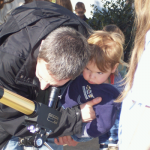
For at least three years now, the Huntsville Botanical Gardens has included VBAS Sidewalk Astronomy in their plans for their Spring and Fall campouts. We bring telescopes and star maps; they provide s’mores and a few dozen school-age children who will give us 20 minutes to wow them with a night sky wonder.
The first one arrives with a poker face: an expression that may be skeptical or shy. She may have a head full of facts (half of them newly outdated) from a brand-new astronomy book, or he may wonder how the big tube in the middle of the field could possibly be as exciting as the swift and silent owls he just saw over in the amphitheater.
What’s wonderful for a seven-year-old with a tummy full of marshmallows and chocolate?
Gadgets. It’s exciting for a child to be empowered by a new tool, and to see immediately how that tool changes his world. Extra points are added if the tool is one his parents do not already have. It’s rare that we get the opportunity to surpass our older and wiser parents, but telescopes are rare enough (even in the Rocket City) that many parents don’t have one, and perhaps even have never looked through one. Score one for the new kid in town.
Surprises. Looking into a telescope is like looking into a magic box. If you have a book about the Moon, with a picture on the cover, you have some idea what the pictures inside may look like. On the other hand, the telescope doesn’t carry a preview feature. Waiting in a short line and climbing a ladder increase the anticipation as a child forms her own mental picture of the view through the eyepiece. She spends a moment staring at a foggy black circle, shifting her eye slowly, and then: “Wowww!” Yep. She saw it. There is no faking the exclamation of wonder when she finally sees the bright rays around Tycho crater.
Connections. The bright dot in the East there, over the Sorghum Maze? That’s the thing my new friend just saw in the mysterious gadget. It looks a little like the striped planet in his book about the solar system . . . the one with all the moons. Wouldn’t it be cool to watch 65 or more moons chase each other through the sky, instead of the lonely one Moon we have? Looking through that telescope takes abstract concepts and disconnected facts, and brings them right here to Earth in Huntsville.
New skills. The regular VBAS observers know I have fallen in love with the 8″ Dob recently donated to the Society. I love it because there are 3 simple, child-friendly steps to using it: 1) look at the Moon, 2) grab the tube and point it where you’re looking, and 3) look to see if you pointed correctly. The reward is a breathtaking view no one else can see until it is their turn to try those three steps. In five minutes, a child as young as four or five knows how to do something cool! In the midst of music lessons (a month to learn a short, slow song), first bicycle rides (untold numbers of wobbly starts before the first successful sprint), and school tests (in which succeeding means moving on to another round of unfamiliar words or numbers), this simple success offers an encouraging platform for a lifelong hobby. Better still, success can still be found on a cloudy night: there are at least two radio towers visible from the Gardens’ campout site which make great targets for new telescope users.
In the past three years, at least a half dozen VBAS observers have re-discovered the things that hooked us into astronomy in the first place. Megan, James and Melissa had a great session on September 16. John Young is heading the October 7 session, and Society scopes are available for checkout. Can you have more fun than we did? We double-dog-dare you to try!